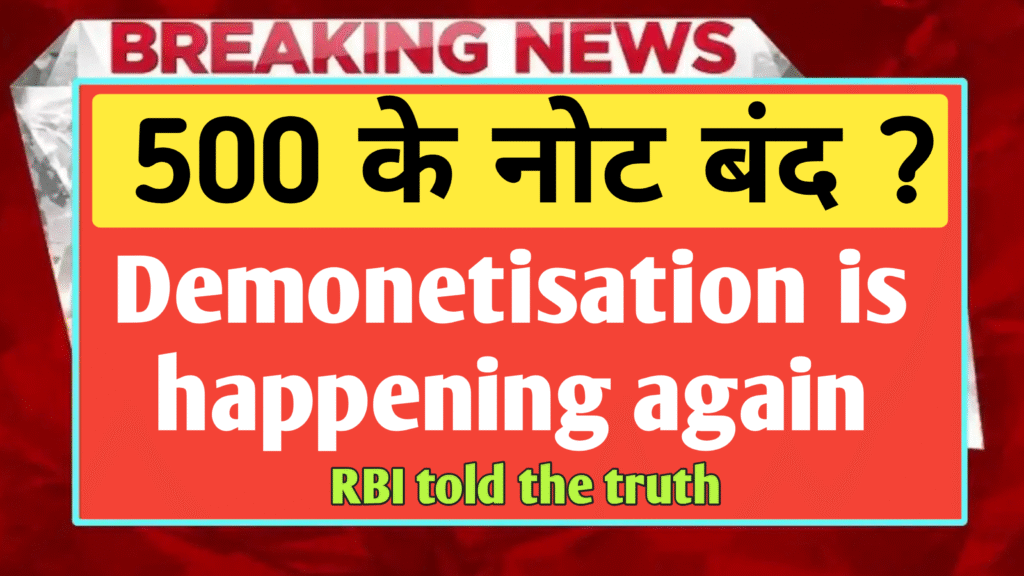New Delhi, India – Following the withdrawal of ₹2000 notes from circulation, the ₹500 note has solidified its position as the highest denomination and most widely used currency in India. It currently accounts for approximately 41% of the total currency notes in circulation and a significant 86% of the total value of currency. In recent days, social media platforms have been abuzz with a viral claim suggesting that the government is preparing to ban ₹500 notes as well. This widespread rumor has caused considerable concern and confusion among citizens. However, the Reserve Bank of India (RBI) has stepped forward to clarify the situation, debunking these baseless claims.
A viral social media post recently claimed that the Reserve Bank of India (RBI) would soon ban the ₹500 note, stirring panic across the nation. According to the unfounded rumor, ATMs will dispense only ₹100 or ₹200 notes soon, rendering ₹500 notes as useless. Here’s everything you need to know—and the truth behind the noise.
The Viral Claim: Is the ₹500 Note Headed for Demonetization?
The social media posts rapidly circulating online assert that the RBI is on the verge of making a decision to discontinue the ₹500 note. These claims often paint a picture of a phased withdrawal, similar to the ₹2000 note demonetization, suggesting that soon, a staggering 90% of ATMs will only dispense ₹100 or ₹200 notes. This narrative explicitly links the purported increase in smaller denomination notes in ATMs to a grand scheme to phase out the ₹500 note. The language used in these viral messages is often alarmist, urging people to question the validity of their ₹500 notes and speculate about their future worth.
The rapid spread of such unverified information highlights the challenges of misinformation in the digital age, especially concerning a sensitive topic like currency.
Why the Confusion? RBI’s Push for Smaller Notes
The confusion arose from an April 2025 circular by the RBI requiring banks to ensure that at least 75% of ATMs dispense ₹100 or ₹200 notes from one cassette, increasing to 90% by March 31, 2026. This directive is purely operational—aimed at improving the availability of small-denomination currency for daily transactions—not phasing out higher denominations.
Data from ATM management firms shows a notable rise in such machines: 73% of ATMs are now configured to dispense ₹100/₹200 notes, up from 65% in December 2024 This is part of the RBI’s Sept 30, 2025 plan, to enhance access to smaller notes—not to eliminate ₹500 notes.
RBI and Government Statement: Calm the Panic
Both the PIB Fact Check and the RBI have publicly labeled the viral claims as misleading and baseless.
- The ₹500 note continues to remain legal tender, with no dematerialisation planned.
- The RBI is printing new ₹500 notes even now, underscoring the denomination’s continuity.
- The ATM rule is about inclusive access, not withdrawal.
Union Finance Minister also affirmed that ₹500 notes will remain in circulation, and urged citizens to only trust official channels.
Why This Matters—and What You Should Do
- No action needed. Continue using your ₹500 notes with confidence—they remain valid.
- Stay informed. Check RBI’s official website and PIB Fact Check for reliable updates.
- Beware of scam channels. The viral video originated on a non-official YouTube page and lacks credibility
Also Read:
Broader Context: RBI’s Currency Management
Since demonetisation in 2016, RBI has introduced new ₹500 notes and continues to enhance security features—including watermarks, security threads, and optically variable ink
- Gradually raise the share of small notes in ATMs for consumer convenience.
- Continue printing ₹500 and ₹2,000 notes where necessary.
- Maintain legal tender status for all active denominations
The move is designed to ensure that citizens have easier access to smaller denominations, facilitating everyday purchases and reducing the hassle of finding change, particularly after the ₹2000 note was phased out. This strategic decision is aimed at:
- Promoting smoother retail transactions: Making small value exchanges more convenient.
- Ensuring adequate availability of all denominations: A well-balanced currency ecosystem.
- Addressing public demand: Catering to the preference for smaller notes for daily needs.
This operational adjustment to ATM dispensation should not be misinterpreted as a precursor to the demonetization of the ₹500 note. It is a proactive step by the RBI to streamline cash management and enhance public convenience, entirely unrelated to any purported plan to withdraw ₹500 notes.
Implications for the Public and Economy
There is no cancellation, demonetisation, or discontinuation of the ₹500 currency note. It remains fully valid and widely used. The RBI’s push to include more ₹100/₹200 notes in ATMs is simply an operational shift aimed at improving user convenience, especially for small-value transactions.
The recent viral misinformation underscores the importance of digital literacy and critical thinking among internet users. Before believing or sharing any news, especially concerning financial matters, it is vital to verify the information from credible sources like the official RBI website, government press releases, or reputable news outlets. Spreading unverified information can lead to unwarranted panic, black-marketing, and even financial losses for unsuspecting individuals.
In conclusion, rest assured that your ₹500 notes are safe and remain valid legal tender. The RBI has unequivocally debunked the rumors, urging the public not to fall prey to such misleading claims. The focus remains on improving the availability of all denominations to ensure seamless economic activities across the nation.


















3 Comments
Pingback: Income Tax Alert : What Is the Cash Deposit Limit in Bank Accounts and When Do You Receive a Notice? - TG Tips Bhaiya
Pingback: ₹5 Coin Withdrawn from Minting: RBI Takes Bold Step Over Security and Economic Concerns - TG Tips Bhaiya
Great write-up, I am regular visitor of one’s website, maintain up the nice operate, and It is going to be a regular visitor for a lengthy time.